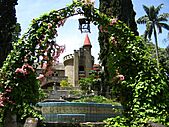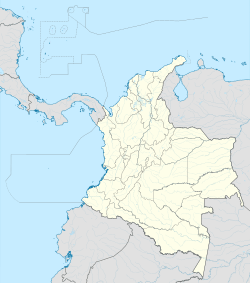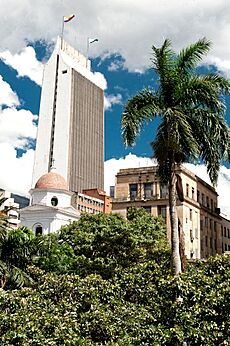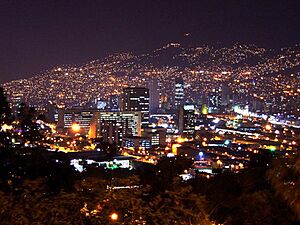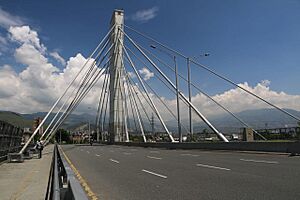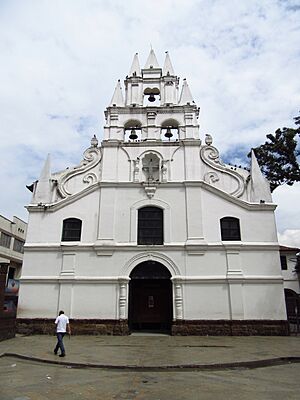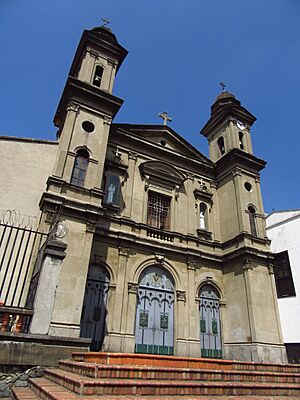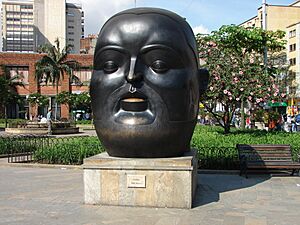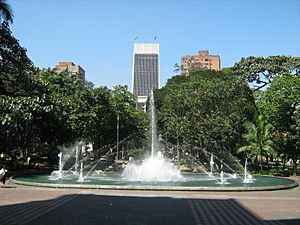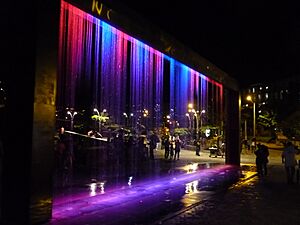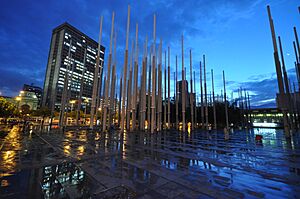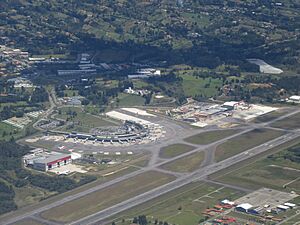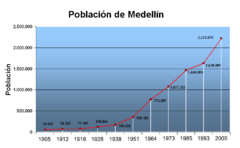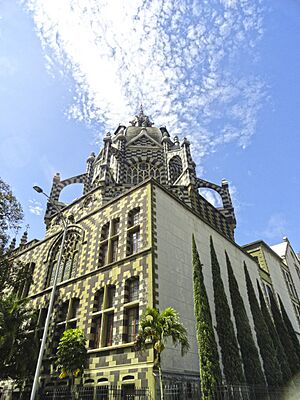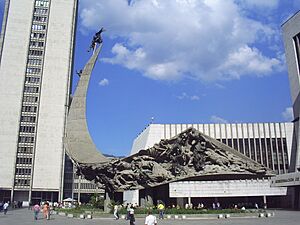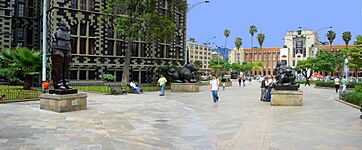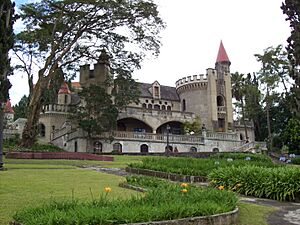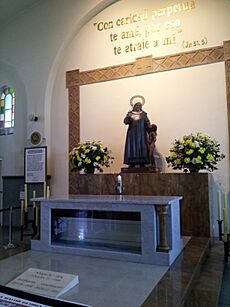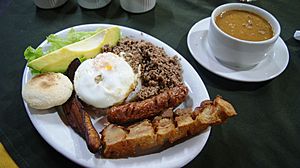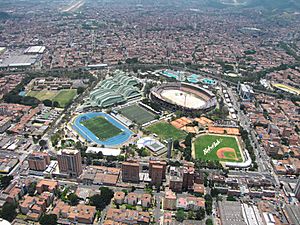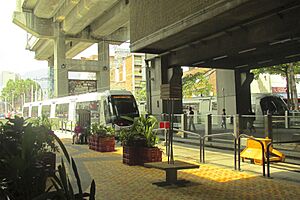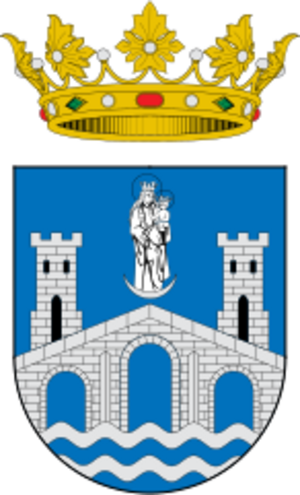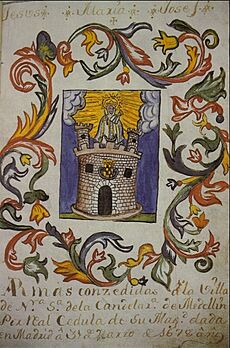Medellín facts for kids
Quick facts for kids
Medellín
|
|||
|---|---|---|---|
|
District and city
|
|||
|
Downtown Medellín
EPM Library
La Alpujarra
El Castillo Museum
Coltejer Building
Parques del Rio
El Poblado District
|
|||
|
|||
| Nickname(s):
Ciudad de la eterna primavera (City of the Eternal Spring)
Capital de la montaña (Capital of the Mountain) Ciudad de las flores (City of the Flowers) |
|||
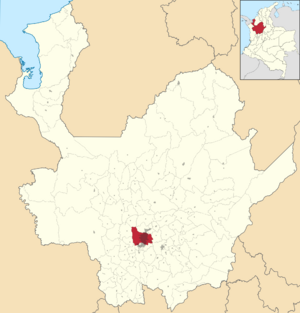
Location of Medellin in Antioquia
|
|||
| Country | |||
| Region | Aburrá Valley | ||
| Department | |||
| Founded | 3 March 1717 | ||
| Named for | Medellín Village | ||
| Government | |||
| • Type | Mayor–council | ||
| • Body | Alcaldía de Medellín | ||
| Area | |||
| • District and city | 380.64 km2 (146.97 sq mi) | ||
| • Urban | 120.9 km2 (46.7 sq mi) | ||
| • Metro | 1,152 km2 (445 sq mi) | ||
| Elevation | 1,495 m (4,905 ft) | ||
| Population
(2020)
|
|||
| • District and city | 2,700,702 | ||
| • Density | 6,759/km2 (17,510/sq mi) | ||
| • Urban | 2,490,164 | ||
| • Urban density | 20,596/km2 (53,340/sq mi) | ||
| • Metro | 3,731,447 | ||
| • Metro density | 6,925/km2 (17,940/sq mi) | ||
| Demonym(s) | Medellinense | ||
| GDP (PPP, constant 2015 values) | |||
| • Year | 2023 | ||
| • Total (Metro) | $72.6 billion | ||
| • Per capita | $17,600 | ||
| Time zone | UTC−05:00 (COT) | ||
| Area code(s) | +57 604 | ||
| Climate | Tropical rainforest | ||
| International airports | José María Córdova International Airport | ||
| Rapid transit system | Medellín Metro, SITVA | ||
Medellín is a big city in Colombia. It is the second-largest city in the country, right after Bogotá. Medellín is also the capital of the Antioquia region. It is located in the Aburrá Valley, which is a central part of the Andes Mountains in South America. The city is often called the "City of the Eternal Spring" because its weather is pleasant all year round.
In 1616, a Spanish explorer named Francisco de Herrera Campuzano started a small village here. Later, in 1675, the "Town of Our Lady of Candelaria of Medellín" was officially founded. In 1826, Medellín became the capital of the Antioquia region. During the 1800s, it grew into an important trading hub, first for gold and then for coffee.
Today, Medellín is a modern and lively city. It has a great public transport system called the Medellín Metro. The city is known for its focus on science, technology, and innovation. It has also become a popular place for tourists to visit. Medellín is important for its universities, businesses, and colorful festivals. In 2013, it was even named the most innovative city in the world!
Contents
- What's in a Name? The Story of Medellín's Name
- A Look at Medellín's History
- Where is Medellín? Its Geography
- How Medellín is Governed
- Medellín's Economy
- City Development and Innovation
- Learning in Medellín: Education
- Getting Around: Transportation
- Who Lives in Medellín? Demographics
- Medellín's Culture
- Delicious Food: Cuisine
- Fun and Games: Sports and Recreation
- City Symbols
- Global Connections: International Relations
- Images for kids
- Famous People from Medellín
- See also
What's in a Name? The Story of Medellín's Name
The area where Medellín stands today had many names over the years. Some of these names included "Valley of Saint Bartholomew" and "Saint Lawrence of Aburrá."
The name "Medellín" comes from a small village in Spain. This Spanish village was the birthplace of Hernán Cortés, a famous explorer. The Spanish village itself was named "Metellinum" after a Roman general. In 1674, the Spanish monarchy agreed to name the new settlement in America "Villa de Nuestra Señora de Medellín."
A Look at Medellín's History
Early Days and Settlers
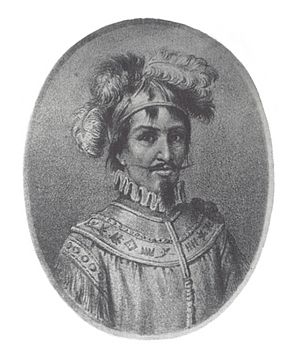
In 1541, a Spanish explorer named Marshal Jorge Robledo discovered the Aburrá Valley. The Spanish first called it "Valley of Saint Bartholomew." But soon, they started using its native name, Aburrá, which meant "Painters." This name came from the colorful clothes of the local people.
In 1616, a settlement called Poblado de San Lorenzo was started. This area is now known as El Poblado. Later, a new town was built in the Aná region, which is the city center today. A church called Nuestra Señora de la Candelaria de Aná was built there.
How Medellín Grew
After 1574, more people started to move to the valley. The population grew because the valley was a good place to get food for the gold mines nearby. It was also in a good spot between the mines and the first capital of Antioquia.
Over time, the original capital, Santa Fe, became less important. More trade and important people moved to the Aburrá Valley. The settlers wanted their own government, separate from Santa Fe. In 1674, the Spanish queen signed an order to create a new local government. The new city was officially named Villa de Nuestra Señora de la Candelaria in 1675.
During Spanish Rule
At first, the buildings in Medellín were simple. The church and government buildings were not very grand. But during the 1700s, the church was improved. In 1682, traders started building the Veracruz Hermitage, which became a church.
The first count of people in 1675 showed about 3,000 people. By 1808, just before Colombia became independent, the city had grown to over 15,000 people. In 1803, a royal college was founded. This college later became the University of Antioquia in 1901. It was very important for learning and culture in the region.
The Industrial Revolution in Medellín
In the first half of the 1900s, Medellín's population grew very fast. The city started to become a major industrial center. After a civil war, Medellín continued to develop its industries. A Chamber of Commerce was created to help connect Medellín with other parts of Colombia and the world.
Coffee became a very important export for Colombia. This helped Medellín's trade grow internationally. The city's strong business spirit led to the creation of many important industries in Colombia.
One of the most important textile companies, Coltejer, was founded in Medellín in 1907. Its main building, the Coltejer Building, is the tallest skyscraper in Medellín. The discovery of coal nearby and the building of hydroelectric plants provided energy for new factories. The Antioquia Railway, built in 1875, helped connect Medellín to the Magdalena River, a major river in Colombia. In 1932, Medellín also built its first airport.
Art and Culture in the Early 1900s
Art and literature have always been important in Medellín. Universities like the University of Antioquia helped create a group of thinkers and artists. Writers like Tomás Carrasquilla wrote about the daily lives of people in Antioquia. Other artists and poets also became famous. Medellín became a center for music, with record labels being founded there.
Many clubs and theaters were built, showing the city's growing cultural life. The first movie distributor in Colombia, Cine Colombia, was founded in Medellín in 1927.
Medellín's Growth in the Late 1900s
In the 1950s, many people moved from rural areas to Medellín. This caused the city's population to grow very quickly. City leaders created a "Medellín Master Plan" to help the city expand. This plan aimed to organize the city's growth, control new settlements, and create industrial zones.
By 1973, the population had tripled. This fast growth led to new challenges, like more people living in informal settlements. Many old buildings were replaced with new towers and avenues.
Medellín Today
Medellín has worked hard to overcome its challenges. The Medellín Metro became a symbol of the city's progress. The Plaza Mayor was built as an international center for events and business.
The city has also improved its public transport to help people in poorer areas. New public buses called "Metroplus" and cable cars called "MetroCable" connect hillside communities to the city. In 2011, a long electric escalator was built in Comuna 13, one of the city's neighborhoods. Today, Medellín focuses on art, education, and including all its people in its development.
In 2012, Medellín was nominated as one of the most innovative cities in the world. This was because of its great public transport, bike-sharing program, new libraries, and the electric escalator. Medellín also has the biggest research building in Colombia, called the University Research Building.
Where is Medellín? Its Geography
Medellín is divided into 16 districts called comunas and 5 rural areas called corregimientos. The city is located in the Aburrá valley, which is about 1,500 meters (4,921 feet) above sea level. The Medellín River flows through the valley.
North of the valley are towns like Bello and Copacabana. To the south are towns like Itagüí and Envigado.
Medellín's Climate
Medellín has warm weather all year round. It has a tropical rainforest climate, but because it's high up in the mountains, it's not as hot as other cities near the equator. The city's average temperature is about 23°C (73°F). Temperatures usually stay between 17°C (63°F) and 28°C (82°F). This pleasant weather is why Medellín is known as the "City of the Eternal Spring."
| Climate data for Medellín (Olaya Herrera Airport), elevation 1,490 m (4,890 ft), (1991–2020) | |||||||||||||
|---|---|---|---|---|---|---|---|---|---|---|---|---|---|
| Month | Jan | Feb | Mar | Apr | May | Jun | Jul | Aug | Sep | Oct | Nov | Dec | Year |
| Record high °C (°F) | 33.2 (91.8) |
35.0 (95.0) |
36.0 (96.8) |
35.0 (95.0) |
36.2 (97.2) |
36.5 (97.7) |
35.6 (96.1) |
36.5 (97.7) |
38.0 (100.4) |
36.5 (97.7) |
37.0 (98.6) |
35.0 (95.0) |
38.0 (100.4) |
| Mean daily maximum °C (°F) | 27.9 (82.2) |
28.3 (82.9) |
28.2 (82.8) |
27.8 (82.0) |
27.9 (82.2) |
28.3 (82.9) |
28.6 (83.5) |
28.7 (83.7) |
28.1 (82.6) |
27.3 (81.1) |
27.1 (80.8) |
27.3 (81.1) |
28.0 (82.4) |
| Daily mean °C (°F) | 23.0 (73.4) |
23.3 (73.9) |
23.1 (73.6) |
22.8 (73.0) |
23.0 (73.4) |
23.7 (74.7) |
24.0 (75.2) |
23.9 (75.0) |
23.2 (73.8) |
22.2 (72.0) |
22.0 (71.6) |
22.5 (72.5) |
23.1 (73.6) |
| Mean daily minimum °C (°F) | 17.5 (63.5) |
17.8 (64.0) |
17.9 (64.2) |
17.9 (64.2) |
18.0 (64.4) |
17.7 (63.9) |
17.5 (63.5) |
17.6 (63.7) |
17.5 (63.5) |
17.4 (63.3) |
17.6 (63.7) |
17.6 (63.7) |
17.7 (63.9) |
| Record low °C (°F) | 9.5 (49.1) |
8.0 (46.4) |
9.0 (48.2) |
9.5 (49.1) |
10.0 (50.0) |
10.0 (50.0) |
8.9 (48.0) |
10.0 (50.0) |
9.6 (49.3) |
9.0 (48.2) |
9.0 (48.2) |
8.2 (46.8) |
8.0 (46.4) |
| Average precipitation mm (inches) | 141.0 (5.55) |
148.8 (5.86) |
250.9 (9.88) |
299.8 (11.80) |
238.5 (9.39) |
87.2 (3.43) |
56.0 (2.20) |
53.4 (2.10) |
114.9 (4.52) |
276.1 (10.87) |
327.3 (12.89) |
244.4 (9.62) |
2,238.2 (88.12) |
| Average precipitation days (≥ 1 mm) | 8.0 | 9.3 | 13.6 | 17.7 | 18.6 | 14.2 | 13.5 | 14.4 | 16.4 | 19.5 | 16.9 | 11.3 | 173.4 |
| Average relative humidity (%) | 66 | 65 | 67 | 70 | 70 | 66 | 63 | 65 | 67 | 71 | 72 | 70 | 67 |
| Mean monthly sunshine hours | 170.5 | 152.6 | 148.8 | 123.0 | 139.5 | 165.0 | 198.4 | 186.0 | 147.0 | 133.3 | 135.0 | 151.9 | 1,851 |
| Mean daily sunshine hours | 5.5 | 5.4 | 4.8 | 4.1 | 4.5 | 5.5 | 6.4 | 6.0 | 4.9 | 4.3 | 4.5 | 4.9 | 5.1 |
| Source: Instituto de Hidrologia Meteorologia y Estudios Ambientales (humidity, sun 1971-2010) | |||||||||||||
How Medellín is Governed
Medellín is run by a democratic system. The Mayor of Medellín and the Municipal Council are chosen by the people. They work together to manage the city.
The city has different departments that handle things like education, public works, and transportation. There are also special groups that manage things like the airport, libraries, and the Medellín Metro.
The city is divided into 16 urban comunas (districts) and 5 corregimientos (rural townships). Medellín is also part of the larger Medellín Metropolitan Area, which includes ten nearby towns.
City Zones
- South-eastern: El Poblado
- South-western: Guayabal and Belén
- West-central: Laureles, La América and San Javier
- East-central: La Candelaria, Villa Hermosa and Buenos Aires
- North-western: Castilla, Doce de Octubre and Robledo
- North-eastern: Aranjuez, Manrique, Popular and Santa Cruz
- Rural Areas (Corregimientos): San Sebastián de Palmitas, San Cristóbal, Altavista, San Antonio de Prado and Santa Elena.
Medellín's Economy
Medellín is the second most important economic center in Colombia. Its economy is led by a powerful group of local businesses. This group includes companies in banking, food, and cement. Many national and international companies have their main offices in Medellín.
The city's main products are steel, textiles, clothing, food, and flowers. Fashion is a very important part of the city's economy and culture. Medellín hosts Colombiamoda, which is Latin America's biggest fashion show.
The Metropolitan Area of Medellín creates about 70% of the total economic output of the Antioquia region. This makes Antioquia the second-largest economic region in Colombia.
Business Clusters in Medellín
Medellín has created the first "business cluster" in Colombia. This means that many companies in the same industry work together to grow. Medellín is a top exporting region, with many businesses that sell products to other countries. The main activities in this cluster are electricity, textiles, fashion, construction, tourism, and business.
Ruta N is a special organization in Medellín that helps foreign companies set up their offices in the city.
Jobs and Living in Medellín
The number of people living in poverty in Medellín has gone down a lot in recent years. This is because more people have access to basic services like health, education, and public services. The number of people without jobs has also decreased.
City Development and Innovation
Medellín is growing quickly, with many new tall buildings being constructed. In 2013, Medellín was named "Innovative City of the Year" by the Wall Street Journal. It beat out cities like New York City!
Libraries and Library Parks
Medellín has a special idea called "library parks." These are places where a library building is surrounded by green spaces for everyone to use. They are built in neighborhoods that need more cultural and educational spaces. These parks help promote learning, culture, sports, and fun activities.
One famous library park is the Biblioteca Parque España. Other library parks include León de Greiff Library and San Javier Library Park. The idea of "library parks" from Medellín has been used as a model in other countries too.
Medellín also has a network of over 100 libraries that share resources. This network helps improve education and culture for everyone. In 2009, this library network won an award from the Bill & Melinda Gates Foundation.
Medellín's Architecture
Medellín doesn't have much old colonial architecture left. Most of its buildings are from the 1800s and 1900s. Many buildings from the Republican era (1850-1930) used brick and European styles. The Metropolitan Cathedral of Medellín was finished in 1931. Other important buildings from this time include the old Municipal Palace and the Palace of Departmental Government.
Parks and Green Spaces
Medellín has many beautiful parks. Berrío Park is in the city center, and Bolívar Park is a bit further north. Modern parks like Barefoot Park and Wishes Park are interactive and fun.
One of the most visited places is the Arví Ecotourism Park. It's a huge park with trails, lakes, and forests where you can hike, bike, and enjoy nature. It also offers great views of the city.
The city is surrounded by seven hills that offer natural viewpoints. These hills are great for recreation, sports, and enjoying nature. The Nutibara Hill is home to a small replica of a traditional Antioquian village.
Other parks include North Park and Juan Pablo II Park. The Santa Fe Zoo has about 1,000 animals from different parts of the world.
Plazas and Public Squares
- Plaza Cisneros: This plaza has a "forest" of tall light poles that light up at night. It's a modern public space.
- Botero Plaza: This plaza is famous for its 23 large sculptures by the artist Fernando Botero. It's a popular spot for visitors.
- Zea Plazuela: An older square with some original buildings and a sculpture of Francisco Antonio Zea.
- Freedom Square: A large public plaza that is still being built. It will be a place for government offices and public events.
- Plazuela Nutibara: A historic square with important buildings like the Palace of Culture and the Nutibara Hotel.
- Plazuela San Ignacio: A traditional square with the San Ignacio Church and the historic building of the University of Antioquia.
- Plazuela de La Veracruz: This square is named after the Church of La Veracruz. It has a fountain and a monument to a hero of independence.
Learning in Medellín: Education
Medellín is home to over 30 universities. Some of the most important public universities include the University of Antioquia and the National University of Colombia.
There are also many important technology schools. The city has focused on improving public education by building new schools and libraries in different neighborhoods. Many private schools are also in the city, some run by the Catholic Church or other organizations.
Many groups help children and young people from less wealthy communities. Universities and official institutions also work to improve opportunities for youth.
Getting Around: Transportation
Air Travel
Medellín has two airports. Olaya Herrera Airport (EOH) is within the city. José María Córdova Airport (MDE) is located outside the city in Rionegro, about 29 kilometers (18 miles) away. This airport handles most international flights from major airlines.
Land Travel
Medellín has two main bus terminals for travel by land. The city's public transport system includes buses, taxis, trams, and the Medellín Metro. The Metro is the only subway system in Colombia.
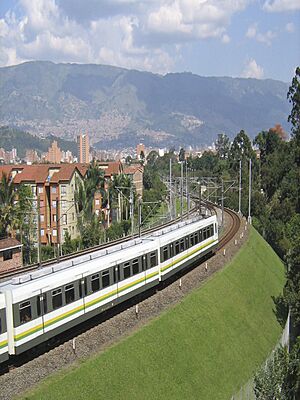
The Metro connects Medellín with most of its surrounding areas. It has five lines, including cable car lines called Metrocable. These cable cars help connect neighborhoods on the hillsides to the city center. There's even a special tourist line that goes to Arví Park.
In 2011, a new bus rapid transit system called Metroplús opened. It has special lanes for buses to move faster. This system helps reduce pollution and traffic in the city.
Medellín also has a modern tram system, the Ayacucho Tram, which opened in 2015. Trams were used in Medellín until 1951, and now they are back!
The Western Tunnel, which is 4.6 kilometers (2.9 miles) long, connects Medellín to Santa Fe de Antioquia. It's one of the longest tunnels in Latin America.
Public Transport Use
On average, people in Medellín spend about 66 minutes commuting using public transport on a weekday. The average wait time at a stop is about 11 minutes. People usually travel about 5.9 kilometers (3.7 miles) in one trip.
Who Lives in Medellín? Demographics
The Aburrá Valley is home to 58% of the people in the Antioquia region. Most of these people live in Medellín. In 2005, Medellín had over 2.2 million people, making it the second-largest city in Colombia. The wider metropolitan area had over 3.3 million people.
Most people in Medellín (61.3%) were born in the city. About 38% were born in other parts of Colombia. Almost all homes in Medellín have electricity and drinking water.
Different Backgrounds
Most people in Medellín are of White or Mestizo (mixed European and Indigenous) background. About 6.5% of the population is Black, Mulatto, or Afro-Colombian. A very small number are Indigenous Amerindians.
Over the centuries, Medellín has welcomed immigrants from Spain, Ireland, Scotland, England, Italy, Germany, and countries in the Middle East. Many people from Medellín are called Paisas, a name for people from this region, often with Spanish roots.
People also move to Medellín from other parts of Colombia, especially young people who come to study at universities.
Medellín's Culture
Medellín's culture is closely linked to the wider Paisa culture. This culture has its own Spanish accent, food, and friendly ways. Today, Medellín has many cultural attractions. It has about 40 museums, 21 public parks, 28 theaters, and many public libraries.
Most people in Medellín are Catholic. The city has many beautiful churches, like the Metropolitan Cathedral of Medellín, which is the largest cathedral in the world built entirely of baked brick. Other important churches include the Basilica of Our Lady of Candelaria and the Church of San Ignacio.
In December, Medellín is famous for its amazing Christmas lights. These lights are considered some of the most beautiful in the world!
Plaza Mayor is a big center for events and business. Medellín has many sculptures around the city by famous artists.
The city also has many festivals and exhibitions all year. The silletero tradition is very special to the region. Silleteros carry beautiful flower arrangements on their backs. This tradition is celebrated every year during the Festival of the Flowers.
Paisa Culture
The people of Medellín are often called Antioqueños or Paisas. The word Paisa comes from paisano, meaning "fellow countryman." Paisas are one of the main regional cultures in Colombia. They are known for speaking softly and quickly, smiling easily, and loving music, poetry, and parties. They are very proud of their city and work hard to keep it clean.
Festivals and Events
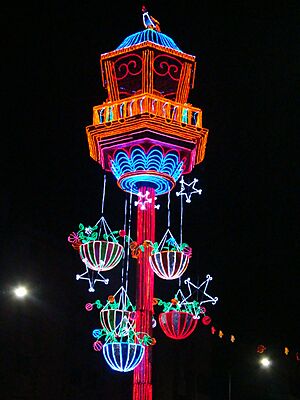
- Festival of the Flowers is held from late July to early August. The main event is the Desfile de Silleteros, a colorful parade where people carry amazing flower arrangements.
- Christmas lighting in Medellín is a traditional event where the city is decorated with millions of Christmas lights.
- International Poetry Festival brings poets from all over the world to share their poems in public places. This festival promotes peace through poetry.
- International Tango Festival celebrates the tango dance and music. Medellín has a strong tango culture, partly because the famous singer Carlos Gardel died there in a plane crash in 1935.
- Book and Culture Festival is a big cultural event held in September. It promotes reading and art with many workshops and exhibitions.
- International Horse Fair is held in October, featuring horse shows and races.
Museums and Fun Places
Medellín has about 40 museums and many art galleries.
- Museum of Antioquia was one of the first museums in Colombia. It's located next to Botero Plaza.
- Museum of Modern Art of Medellín (MAMM) has a great collection of modern art, including paintings and sculptures.
- University Museum, University of Antioquia has collections of ancient pottery, stone tools, and art. It also shows the history of the university.
- Museum El Castillo is a beautiful castle-like building with French-style gardens and exhibits of porcelain and glass.
- Interactive Museum EPM is a fun, educational museum where you can learn about water, energy, gas, and telecommunications.
- Mineralogy Museum has a large collection of minerals and rocks.
- San Pedro Cemetery Museum is a historic cemetery that is also a museum. It has beautiful monuments and hosts concerts and shows.
- House Museum Master Pedro Nel Gómez was the home of the artist Pedro Nel Gómez. It has many of his works.
- Casa Museo Gardeliana celebrates tango culture and the history of Carlos Gardel.
- Parque Explora is an interactive science museum. It has the largest freshwater aquarium in South America.
- Planetarium of Medellín has telescopes and a projection room to explore Earth and space.
Delicious Food: Cuisine
The food in Medellín is part of the larger Antioquian culture. A typical dish is the bandeja paisa. This big meal usually includes beans, rice, pork, sausage, a fried egg, and avocado. It's often served on a large wooden tray.
People traditionally eat meals with arepas, which are flatbreads made from corn. For breakfast, it's common to drink hot chocolate with a slice of cheese. Parva refers to a variety of sweet and savory baked goods, like pan de queso and buñuelos.
You can also find popular Colombian soft drinks from Postobón and a local alcoholic drink called Aguardiente Antioqueño.
Fun and Games: Sports and Recreation
Soccer is the most popular sport in Medellín. The city has two professional soccer clubs: Independiente Medellín and Atlético Nacional. Both teams play at the Atanasio Girardot Stadium. Many famous soccer players are from Medellín.
Horseback riding is also popular in Medellín. The city has encouraged the production of horse equipment. During the Festival of the Flowers, there are large horse parades.
Medellín also has professional basketball teams.
Sports Events
The Atanasio Girardot Sports Complex is the main sports area in the city. It has fields and stadiums for many different sports. It has hosted big events like the 2011 FIFA U-20 World Cup and the 2010 South American Games.
Cycling and BMX
Cycling is another popular sport. Medellín has a velodrome for track cycling and a BMX track. Famous cyclists like Santiago Botero and Olympic gold medalist Mariana Pajón are from Medellín.
EnCicla is Medellín's bike-sharing system. It was the first bike-sharing program in Latin America. It helps people get around the city using bicycles and connects with the public transport system.
City Symbols
Medellín has official symbols: a coat of arms, a flag, and an anthem. These symbols represent the city.
Coat of Arms
The Medellín coat of arms is the oldest symbol of the city. It was given to the city by King Charles II of Spain in 1678.
| Heraldic version | Versions of the municipality bodies | |
|---|---|---|
 |
 |
 |
| With the shape called modern French style | Version used by the Mayor | Version used by the Council |
The coat of arms shows a blue shield with a strong, round tower. It also has a smaller shield with a checkered pattern and an image of "Our Lady of Candelaria" with her child.
Flag
Medellín uses the same flag as the Antioquia region. It has two horizontal stripes: white on top and green on the bottom. The city's coat of arms is in the middle. White stands for purity and honesty. Green stands for hope and freedom.
Anthem
The official anthem of Medellín is the "Anthem of Antioquia." It is sung at all official city events.
Global Connections: International Relations
Sister Cities
Medellín has "sister city" relationships with many cities around the world. This means they share cultural and economic ties.
|
|
Other City Partnerships
Medellín also has other partnerships with cities like:
Images for kids
-
Headquarters of Hewlett-Packard in Route N
Famous People from Medellín
- María Teresa Cano, visual artist
- Carolina Giraldo Navarro singer
See also
 In Spanish: Medellín para niños
In Spanish: Medellín para niños





